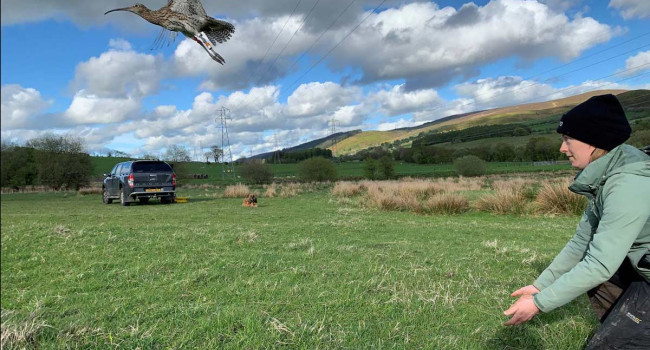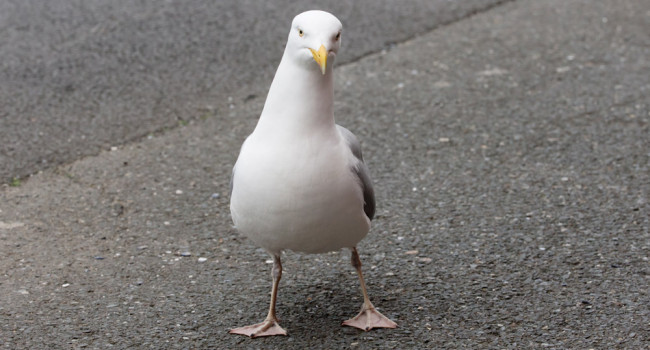Small bird goes large in East Sussex gardens
01 Oct 2011 | No. 2011-40
As autumn draws in, the tiny Goldcrest is winging its way to East Sussex gardens. Goldcrests, which weigh less than a 10 pence piece, occur in a record percentage of gardens locally, latest results from the British Trust for Ornithology’s (BTO) year-round Garden BirdWatch reveal.
Uk's smallest garden bird.
Newly published results from BTO Garden BirdWatch – a community project with over 200 participants in East Sussex alone – show that a greater percentage of local gardens are visited by Goldcrests than anywhere else in the UK and Ireland. Weighing just 6g, the Goldcrest is the UK’s smallest garden bird, and the new results show that autumn is the best time of year to spot them. During October, resident members of this species are joined by their continental cousins, causing the overall population size to swell.
Being so small, Goldcrest numbers often plummet during the chill of autumn and winter, and this is when local gardens are most important. Although relatively infrequent garden guests – tending to visit only 6% of East Sussex gardens on a weekly basis throughout the year – the brief, eye-catching forays of this species onto bird tables and feeders during cold weather can represent the difference between life and death. In particular, suet-based bird foods provide a high calorie lifeline that is easy for their delicate beaks to handle.
There are several reasons why East Sussex gardens are a great place to see Goldcrests. The county has a relatively mild winter climate which helps this diminutive species to survive the cold winter months. Moreover, some of the larger urban areas on the south coast of the county provide warmer microclimates in which this species can seek refuge. Finally, East Sussex is an early port of call for Goldcrests coming in from the continent, across the English Channel, to spend the winter.
East Sussex gardens are not just best for Goldcrest. The elegant Song Thrush, whose warm-coloured plumage and delicate speckles make it a favourite among garden bird lovers, is also seen more often in the county than elsewhere. These exciting findings have emerged thanks to the simple observations of hundreds of local householders who participate weekly in the BTO Garden BirdWatch survey.
Tim Harrison, BTO Garden BirdWatch Development Officer, commented: “With temperatures cooling and invertebrates being harder to find, East Sussex gardens will be increasingly important for Goldcrests and other birds over the coming weeks and months. Recent years have not been easy for Goldcrests, following a trio of unusually cold winters, and no-one knows what this year will have in store. Local householders can help their garden birds by providing a good variety of bird foods, by keeping these foods fresh and by telling the BTO about the birds that they see.”
He added, “BTO Garden BirdWatch is a great community project that helps to conserve the region’s birds. We really want more local people to make their garden count with us so that regional patterns can be explored in more detail. In a new initiative, the BTO is encouraging more local householders to take part by requesting a free ‘taster’ pack, including advice on providing for garden birds. Anyone who watches birds in their garden for at least a few minutes during most weeks can easily give the survey a go.”
For a free BTO Garden BirdWatch taster pack: email gbw [at] bto.org or telephone 01842 750050.
Notes to Editors
- The BTO is the UK’s leading bird research organisation. Over thirty thousand birdwatchers contribute to the BTO’s surveys. They collect information that forms the basis of conservation action in the UK. The BTO maintains a staff of 100 at its offices in Norfolk and Stirling, who analyse and publicise the results of project work. The BTO’s investigations are funded by government, industry and conservation organisations.Visit www.bto.org
- The BTO Garden BirdWatch is the only nationwide survey of garden birds to run weekly throughout the year, providing important information on how birds use gardens, and how this use changes over time. Currently, some 14,000 people take part in the project. The project is funded by participants’ contributions and is the largest year-round survey of garden birds in the world. For more information see www.bto.org/gbw
- For information on the most common garden birds in your area please visit: http://www.postcodebirds.bto.org/
- Data presented here are from BTO Garden BirdWatch in 2010. British and Irish counties were included if 40 or more householders submitted records during every week of the year.
Contact Details
Tim Harrison
(Garden BirdWatch Development Officer)
Office: 01842 750050
(9am-5.30pm)
Email: tim.harrison [at] bto.org
Images are available for use alongside this News Release.Please contact images [at] bto.org quoting reference 2011-40
The BTO has an ISDN line available for radio interviews.Please contact us to book an interview. Office: 01842 750050






Share this page